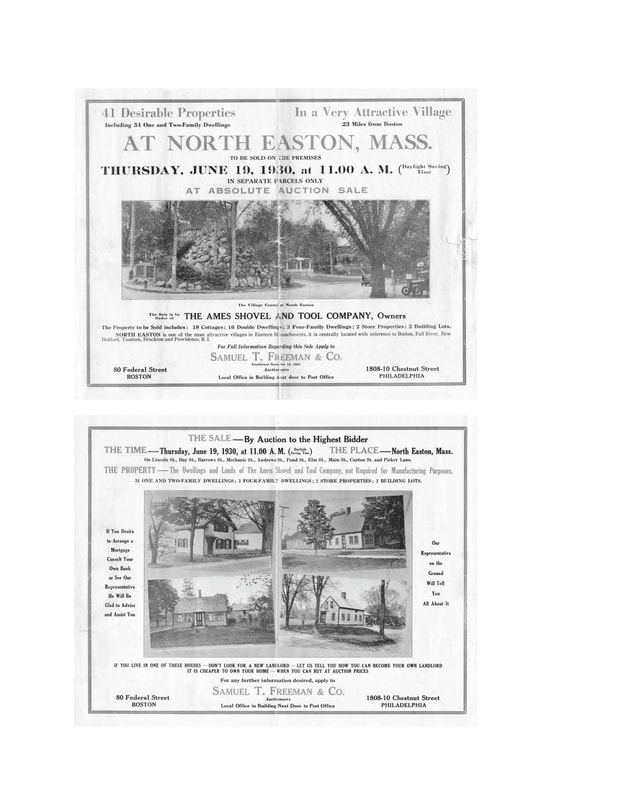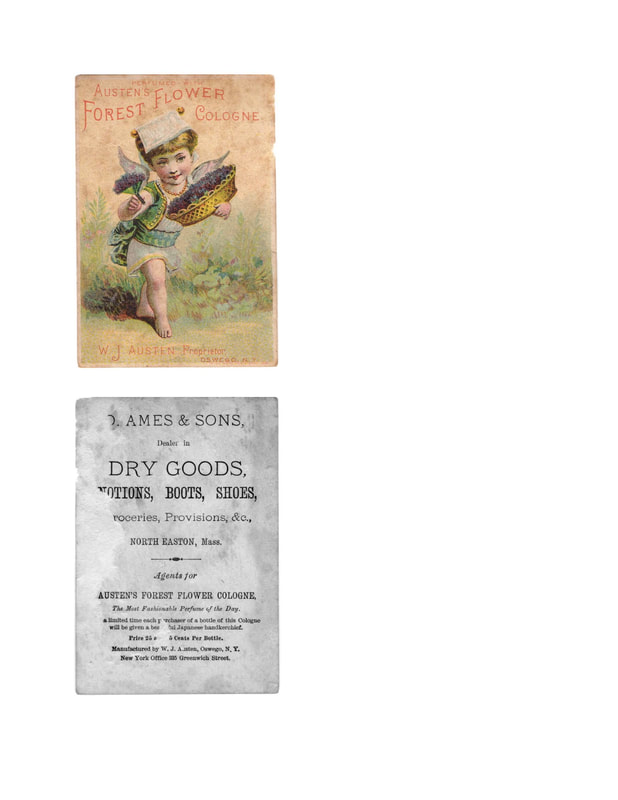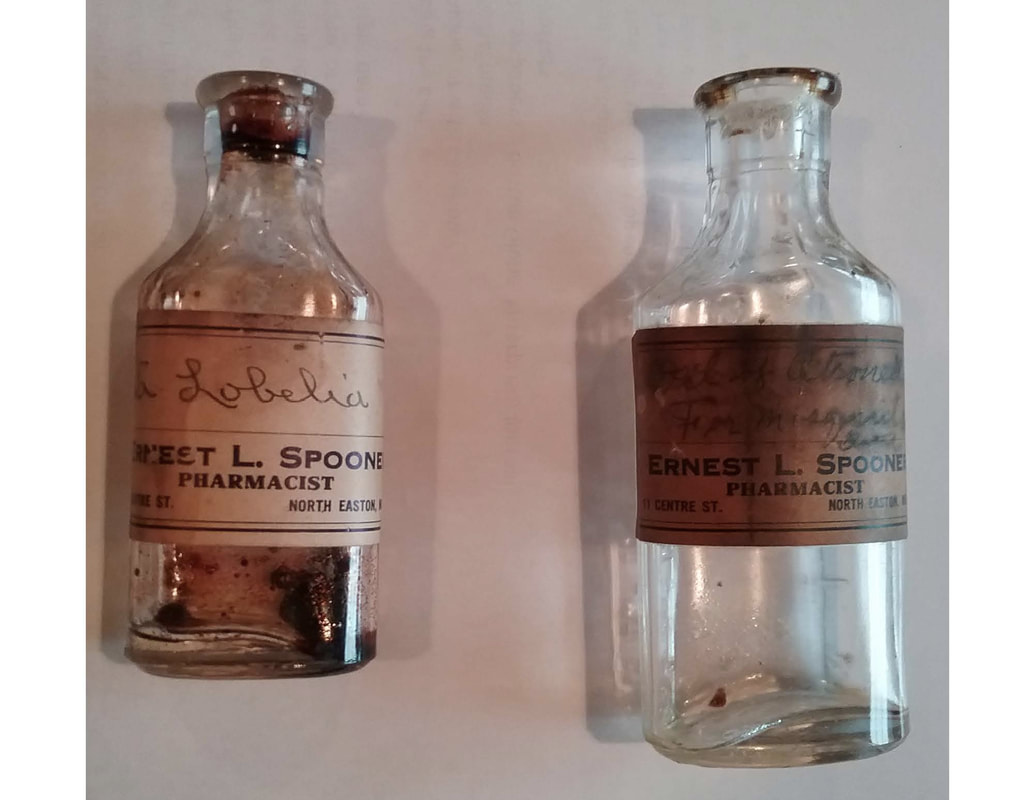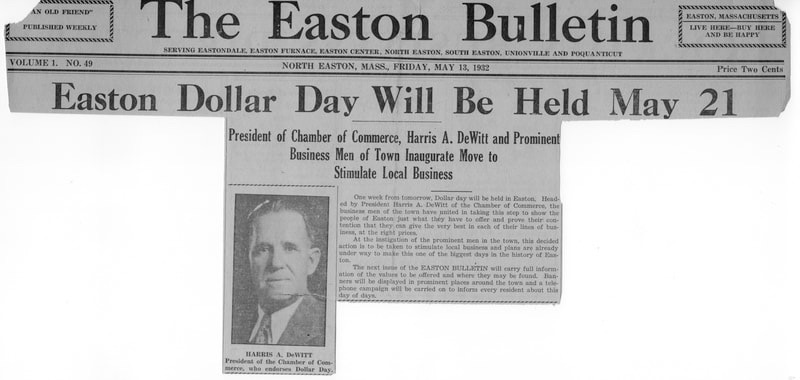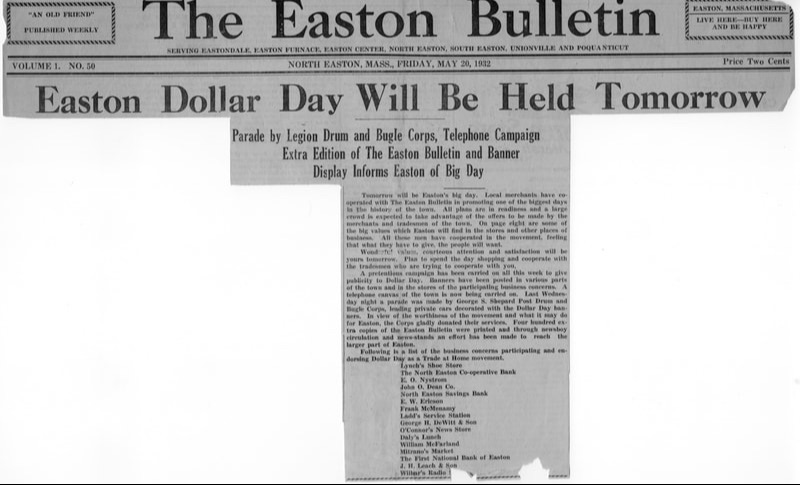|
Greetings from beautiful Easton! Hot summer weather will be our visitor for most of the week, and it seems July is heralding her imminent arrival. Surely cookouts and beach days are being planned!
Ninety-one years ago this week the Ames Shovel and Tool Company began the process of selling many of their company dwellings. Earlier this week, Art Barrett dropped off a sale brochure for that event. Dated for June 19, 1931, and produced by Samuel T. Freeman & Co. of Boston, the brochure offers a number of descriptions and photos of many of the houses that were destined to be auctioned off. A total of 41 properties "In a Very Attractive Village" were being offered for sale to the highest bidder. The realtor set up a local office next door to the former North Easton Post Office building on Main Street for people to inquire at. Terms of the sale were 10% down, and the balance due in 30 days. Why would the Ames Shovel and Tool Company, after more than one-hundred years of offering housing to workers, suddenly exit from the housing business? At the time this was being offered, the country was in the midst of the Great Depression. Just about that time, the company had undertaken a major expenditure, reworking the plant in North Easton, adding several buildings, extensions, and remodeling the former oxen stable on the corner of Main and Oliver Streets to become the company office. Perhaps this was a way for the company to recoup some of the investment made just around the time of the depression? While that may have figured into the company's strategy to survive the financial crisis, there seems to be another reason: the automobile made us a nation of commuters! Inside the sale brochure, this is plainly spelled out as the reason for selling some of the worker housing. The following statements say it all. "WHEN THE AMES SHOVEL CAME TO NORTH EASTON - There was no North Easton. Also, there were no stone roads; no railways; no trolleys; no Automobiles. A village in which the employees could be housed was a necessity. There was no other place for them to live." "TODAY - The beautiful village of North Easton has grown up and within a radius of 15 miles there are perhaps 25 or 30 other Villages, Towns, and Cities - all connected by hard roads kept passable every day of the year. To live in one place and work in another is common practice. Many of the occupants of the Company's dwellings are employed elsewhere. Many of the Company's employees live elsewhere. Many are anxious to own their own homes." Keep in mind that the first shovels made in North Easton were produced in 1803. It was a very different place than it had become by the 1930's. It looks like the advantages of commuting to work finally outweighed the need to live near your work, as the auto and choices of public transportation made that all possible. The American way of work and life was changing! The inside of the brochure lists a map of the lots being sold, a few other house photos, descriptions of the property, and other miscellaneous information. Perhaps your home might have been one of them. If you have any interest in seeing more of the brochure, I will be happy to include that in next week's update. I always look forward to hearing from you! So, until next week, stay cool, stay well, and enjoy the summer weather! Frank
0 Comments
Good morning, afternoon, or evening, and a Happy(?) Juneteenth! This holiday is so new to me I am not sure how to address it. Today we commemorate the day when African American slaves were told of their freedom in Galveston, Texas in 1865. Let us do our part as historians to record the history of African Americans in our communities, and properly remember the people who did so much to build our country.
The summer newsletter is not missing from your mailbox or inbox. Computer issues with my home PC, which has the program I use for the newsletters, is the reason for the delay and I hope that will be rectified soon. Having your computer in the shop for repairs is as bad as having your car in for repairs! It may be Father’s Day tomorrow, but for today I ask the question: What might you get the lady of the house as a gift for a special day? With so many choices available now, I would expect a long list of answers. But what if I asked that question in the 1880’s to someone in Easton? Thanks to Bob Vogel, we were able to find something that might help answer that question. Austen’s Forest Flower Cologne would be a gift worth buying for that special someone. Made in Oswego, N.Y., it was billed as “The most fashionable perfume of the day.” Originating around 1878, and sold under that name until 1886 (when a new owner continued to sell it), the perfume became one of the best-selling scents in America. No one knows what was actually in this compound of fragrant smells, but it sure was popular! How do we know you could purchase this in Easton? The people of that time were pretty adept at advertising their wares. Victorian era advertising cards were all the rage in the years following the Civil War, and into the early 20th century, they were issued in many sizes, styles, and series to make people aware of a product. Austen’s issued a number of these advertising cards, which featured the product on the front, usually accompanied by a scene or other artwork, more information on the reverse, and also included a space to print the name and advertising of the business selling the featured item. We obtained one of the advertising cards for Austen’s Forest Flower Cologne because on the reverse there is an ad for the O. Ames & Sons Store in North Easton. They are noted as a “Dealer in Dry Goods, Notions, Boots, Shoes, Groceries, Provisions, &c.” with the notation “North Easton, Mass.” We know about the Ames Company Store, which was in operation for more than 100 years opposite the Ames Free Library. The card is dated 1881. Now we know one of those special gift items they stocked. There are two more things about this card. On the back, it advertises that “for a limited time each purchaser of this Cologne will be given a beautiful Japanese handkerchief.” Each case of twelve bottles sold to a distributor contained a dozen of these items to be given to each purchaser. The price? Twenty-five and seventy-five cents a bottle, depending on the size bottle you bought. The second interesting item is that in the days before “scratch and sniff” marketing became possible, many of these cards were “perfumed” with the scent of the cologne, offering a way to have the lady of the house sample the fragrance without breaking the seal on the bottle. Our card is marked as such across the top of the front. The scent, however, has passed into history. Wishing you all a great weekend, Frank Happy Saturday greetings! A gentle rain has been falling since last night, and the freshly cut lawn and trimmed hedges will get the full benefit of being well-watered in the next few days. That means, of course, that the mower and clippers will soon be put back to work!
A few weeks ago, I was able to meet with students from the Queset Brook Outdoor Cooperative, a homeschool program that meets at Holy Trinity Lutheran Church on Lincoln Street, where students learned some of the legends and lore of Easton. This past Monday and Tuesday morning, I took our show on the road to the second grade students at Moreau Hall, where they saw artifacts, photos, and heard stories from Easton's history. We met outdoors in a socially distanced and comfortable setting. It has been good to get back in touch with some of our young people after not being able to do so for a year. Arielle Nathanson assisted with both talks, and shared a few "interesting" food recipes from an 1875 cookbook. Note that this took place before lunch both days! During the week we were given two bottles from one of our local druggists, Ernie Spooner (1868-1951). Spooner, whose father Elijah ran a tin store at 10 Center Street, North Easton, worked as a young man for druggist George G. Withington, whose store was located across from the tin shop at what was once 11 Center Street. Studying under Withington, Spooner learned the trade (I assume he may have had some formal schooling, but I do not know where.) Upon Withington's retirement, Spooner took over the business and ran it for many years. The two bottles featured here date to the early 1900's, probably no later than 1920. One bottle contained a medicine known as "tincture of lobelia." Lobelia, a flowering herb, could be used to treat ADHD, depression, asthma, drug addiction, and different respiratory disorders. When used too much or at the wrong dosage, one could suffer severe side effects and even be poisoned by it. The second bottle contained something we all know about - citronella oil. The label on the bottle actually states its use for mosquitos. This product, so common today, was once a prescription remedy. Thanks to William Rose for donating these two bottles. I hope you all have a good weekend, and until next week, stay well! Frank Hello from a beautiful and sunny Easton! Today is Graduation Day for the Oliver Ames High School Class of 2021, the 125th graduating class in the school’s history. I wish all of our graduating seniors the very best and many blessings as they begin the next steps in their life journey. I was able to work closely with three seniors in particular who have been honored with a scholarship from the Society: Emma Varella (granddaughter of Hazel Varella), and Emma Lawson, both of whom worked on a book project last summer; and Samantha Streton, who is this year’s Valedictorian – way to go Sam! – who built our new website and developed a structured internship at the Museum for OAHS students. Please join me in congratulating these seniors, and the entire Class of 2021!
The past year has been an extraordinary one in many ways. The stimulus bills passed by Congress is one of the unusual steps taken to mitigate the economic stress caused by the upheaval of the recent pandemic. How does this compare to past economic downturns? I was searching some files this week, and I came across two articles on a 1930’s version of a stimulus bill for Easton businesses. The event was called “Easton Dollar Day” and it was held May 21, 1932. It appears to be the brainchild of the Easton Bulletin, and it got the attention of the Easton Chamber of Commerce. A few small editorials prior to that day make mention of the poor business climate in Easton at that time as small businesses really struggled for survival in the Great Depression. One writeup more or less takes issue with Eastoners who chose to have their prescriptions filled in Brockton, when the same could be filled in Easton for less money (not to count the additional cost of transportation to Brockton.) The idea is not to pick on Brockton or those who thought they can save money by buying in the city; rather, it was to show that one could spend their hard-earned and scarce dollars in town, and by doing that, give back to the businessmen and women who support the town they live in. Harris A. De Witt, a prominent Easton business man, was also President of the Easton Chamber of Commerce. With a close relationship to the Easton Bulletin, the two organizations began promoting the idea of an Easton Dollar Day where special offerings and discounts would be available to Easton residents from various Easton businesses. One article states “this decided action is to be taken to stimulate local business and plans are already underway to make this one of the biggest days in the history of Easton.” To support the all-out effort, the Bulletin published 400 extra issues the week of the event, banners were hung around town advertising it, a telephone brigade was formed to call as many people in town as possible and tell them about it, and a parade of cars was specially decorated and driven through all sections of town to promote it. Leading the parade was the George S. Shepard American Legion Post Drum and Bugle Corp. The newspaper, who boldly says in its masthead “Easton, Massachusetts – Live Here – Buy Here and Be Happy”, published a front-page article on the day prior to the big sale. While any list of specials could not be found, there is a list of Easton businesses that were scheduled to take part. Those listed are Lynch’s Shoe Store, The North Easton Co-operative Bank, E. O. Nystrom, John O. Dean Co., North Easton Savings Bank, E. W. Ericson, Frank McMenamy, Ladd’s Service Station, George H. De Witt & Son, O’Connor’s News Store, Daly’s Lunch, William McFarland, Mitrano’s Market, The First National Bank of Easton, J. H. Leach & Son, and Wilbar’s Radio Store. I have not found an article or news clipping yet that writes about how well the day went, and whether or not its intended purpose was fulfilled. But it was a good idea to “buy local” and show support for Easton during a very difficult period. It may not be such a bad idea today – a town-wide once a year day to promote all the businesses in Easton and stretch our own dollars just a little further! Until next week, as the paper says, be happy! Frank |
Author
Anne Wooster Drury Archives
June 2024
Categories |
Easton Historical Society and Museum
PO Box 3
80 Mechanic Street
North Easton, MA 02356
Tel: 508-238-7774
[email protected]

